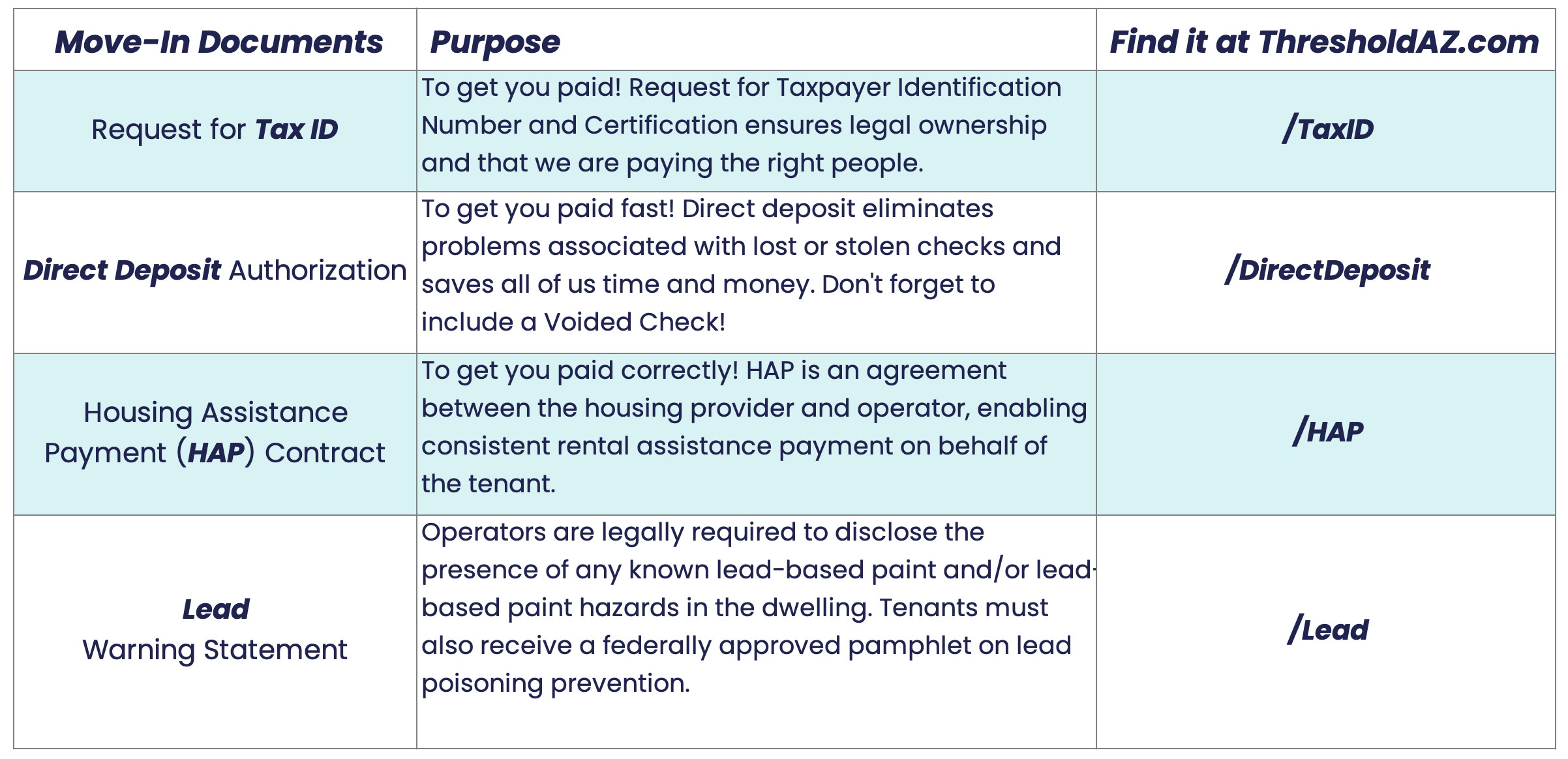Providing stable housing for individuals experiencing homelessness in Arizona comes with a unique set of challenges. One of those challenges is managing the balance between saturation and oversaturation in supportive housing. These concepts are essential in fostering sustainable communities and ensuring that housing remains both accessible and effective. For property owners and operators working with Threshold, understanding saturation and oversaturation is crucial to building successful partnerships and maintaining diverse housing opportunities.
In this blog, we explain what saturation and oversaturation mean in the context of housing. We’ll dive into the local history behind these concepts and show how Threshold works to ensure that housing choices remain diverse and supportive. Property owners can navigate housing challenges by understanding saturation principles. This fosters community integration and dignity for residents.

Balancing saturation in supportive housing helps create inclusive, sustainable communities.
What is Saturation?
It’s important to first define what saturation means when it comes to supportive housing. Saturation refers to the concentration of individuals with similar needs—such as those with serious mental illness (SMI) or experiencing homelessness—within a particular property or neighborhood. A “saturated” property has many residents needing similar support services. This can cause unintended consequences.
While saturation is not inherently negative—as supportive housing is essential for those facing challenges—an imbalanced distribution can lead to issues. These include a lack of diversity within communities, difficulties in providing effective support services, and potential stigmatization of residents, who may already face societal marginalization.
Saturation aims to balance housing needs for vulnerable populations with an environment where residents thrive. Oversaturation in one area can limit housing effectiveness and impede efforts to integrate individuals into the broader community.
What is Oversaturation?
Oversaturation occurs when too many individuals with similar needs are concentrated within one property or neighborhood. While some level of saturation is necessary to guarantee access to appropriate support services, oversaturation can overwhelm these resources, diminish the quality of care, and even hinder the success of supportive housing models.
The key risks of oversaturation include:
- Reduced Quality of Support Services: When too many people with similar needs are placed in one location, the available services—such as mental health support or case management—may become stretched beyond capacity. This causes longer wait times and less personalized support. It reduces housing program effectiveness.
- Community Stigmatization: A neighborhood or property that becomes known for housing a particular group with similar challenges may face negative perceptions. Oversaturation can create a sense of segregation, increasing the stigma that residents may already face due to mental health challenges or homelessness.
- Imbalance in Housing Opportunities: Concentrating supportive housing in one area limits housing for others. It undermines stable housing goals.
- Overburdened Neighborhood Resources: Local services like transportation, healthcare, and education may be overwhelmed. This happens when many with specialized needs are concentrated. This can create tension between residents and service providers and reduce the overall quality of life in the neighborhood.

Saturation in supportive housing refers to the concentration of individuals with similar needs in one area.
The Arnold v. Sarn Case
Arnold v. Sarn (1989) is a significant legal case from Arizona concerning the rights of individuals with serious mental illnesses. Charles “Chuck” Arnold and others sued Arizona’s health director, John Sarn. They claimed inadequate mental health services. The lawsuit centered on Arizona’s obligation under state statutes to provide a comprehensive mental health system for individuals unable to afford treatment.
The Arizona Supreme Court ruled in favor of Arnold, finding that the state had a mandatory duty to provide such services. This decision underscored the state’s legal responsibility to prioritize mental health care, addressing systemic inadequacies in funding and service delivery.
The case catalyzed reforms in Arizona’s mental health system, including expanded access to community-based care and housing programs, improving the quality of life for people with mental illnesses.
Reforms After the Verdict
The Arnold v. Sarn case resulted in significant reforms aimed at improving mental health services and increasing access to supportive housing.
- Saturation and Oversaturation of Housing for Individuals with SMI: Arnold v. Sarn highlighted the state’s responsibility to provide adequate housing and support for individuals with SMI. The ruling emphasized the need for community-based housing options rather than relying solely on institutional settings. This directly connects to the concept of saturation, as the lawsuit addressed concerns about concentrating too many individuals with SMI in inadequate facilities or specific locations, which could lead to ineffective support and stigmatization.
- Prevention of Oversaturation: Another key outcome of the case was the recognition that oversaturation of individuals with SMI in particular facilities or neighborhoods could overwhelm resources and perpetuate negative stereotypes.
- Integration of Supportive Services: Another revelation from the case was the acknowledgment of a lack of accessible, community-based services for individuals with SMI, leading to poor outcomes and reliance on institutional care.
- Advancing Housing Equity: The Arnold v. Sarn verdict also ensures that vulnerable populations, including those experiencing homelessness and SMI, have equitable access to stable housing.
- Systemic Reform and Oversight: Reforms following Arnold v. Sarn introduced monitoring and accountability mechanisms to ensure effective distribution and adequate resourcing of housing and services for individuals with SMI.
Learn More: Read our deep dive on Arnold v. Sarn

The landmark Arnold v. Sarn case emphasized preventing oversaturation and promoting equitable housing solutions.
How We Manage Saturation and Oversaturation
Threshold is committed to balancing the demand for supportive housing with the need for community integration and resource availability. Threshold prevents oversaturation by spreading supportive housing across Arizona’s ZIP codes and cities. This approach spreads housing opportunities out, reducing the concentration of individuals with similar needs in any one area and ensuring that residents have access to a wider variety of local resources and opportunities.
A core element of Threshold’s strategy is to prevent any one property or neighborhood from becoming overwhelmed with residents facing similar challenges. Instead, we distribute supportive housing across diverse communities, allowing individuals to integrate more fully and receive the support they need without being isolated or stigmatized.
We work closely with property owners to make certain that housing distribution follows these principles. We monitor property saturation levels to maintain balanced, diverse residents. This keeps properties functional and supportive.
The Housing and Community Balance
Managing the balance between housing availability and community integration is essential to prevent oversaturation and create environments where individuals can thrive. We envision a system where supportive housing is not isolated in one area but instead distributed across multiple neighborhoods to promote diversity and inclusion.
A balanced mix of residents, including those with supportive services, prevents segregation. It avoids stigmatizing residents.

Decentralizing housing across various neighborhoods creates inclusive environments where individuals receive the support they need without isolation or stigma.
Guidelines for Property Owners and Operators
Threshold provides property owners with practical guidelines to maintain this balance. For example, for properties with more than eight units, Threshold recommends that no more than 25% of the units be designated for Permanent Supportive Housing (PSH). This guideline ensures that there is a healthy mix of residents with varying needs in each property, which helps prevent overcrowding of services and promotes a more diverse community environment.
These guidelines help property owners avoid oversaturation while still fulfilling the growing demand for supportive housing. By adhering to these rules, property owners can provide stable, supportive homes without overwhelming the neighborhood or community resources.
Adapting and Evolving
As the need for supportive housing continues to grow, our approach is continually evolving. The process of balancing saturation and oversaturation is complex, but we remain flexible in our approach to meet the changing needs of individuals experiencing homelessness and the communities they inhabit.
At Threshold, our evolving strategy includes refining its guidelines and increasing its collaborations with service providers and community organizations. We stay informed about neighborhood needs and stakeholder feedback. This ensures diverse, well-distributed housing options.














